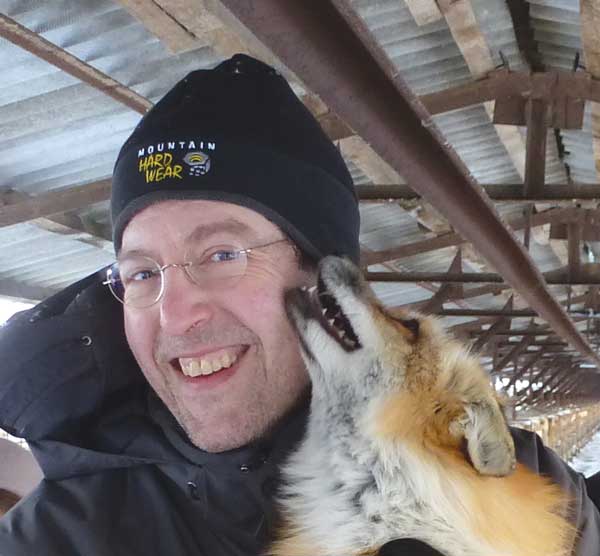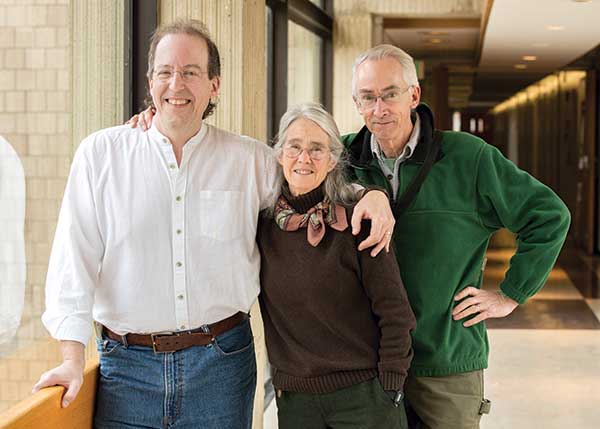Eyewitness to evolution
Scientist shares history of famous fox experiment

It’s midwinter in Novosibirsk and the temperature approaches 40 below. The landscape is blindingly white, the air crystal clear.
Lee Dugatkin, PhD ’91, bumps down small roads toward the Siberian farm where, for six decades, a small team has carried out one of the most ambitious experiments in modern science. The goal? To dramatically condense thousands of years of evolution — and watch as it happens.
The scientists are domesticating foxes and, in the process, learning how wolves once became dogs. All belong to the biological family Canidae.
“It’s covered in snow and it’s freezing,” Dugatkin says. “And the first thing that strikes you is that, even when you are 100 yards away, the foxes know you are coming. You hear this cacophony of sounds of enjoyment. These animals just go nuts.”
Dugatkin had seen the foxes on YouTube. Still, he was not prepared for what happened at the farm, where the small, fuzzy animals licked his face and nibbled his ear within a minute of being put into his arms. “If you get close to their cage, they will roll over on their back and hope that you will rub their stomach,” he says. “It’s mind-boggling. They’re eerily doglike.”
Dugatkin, a distinguished university scholar and professor of biology at the University of Louisville, traveled to Russia twice while researching his latest book, How to Tame a Fox (and Build a Dog), which he co-authored with Lyudmila Trut, head of the Siberian experiment. The volume, intended for a general audience, was published this spring by the University of Chicago Press.
“This is really, arguably, one of the most important experiments that’s been done in biology. Period,” he says.
The new book doesn’t reveal the secrets of some hush-hush Soviet-era project. The fox experiment has been featured on Nova and in National Geographic specials as well as in The New York Times.
Dugatkin says many people nod in recognition when he mentions the project. And within the science of genetics, a lot of people know about it. “A tremendous number of people know a little bit about this work,” he says. “But almost nobody knows all the juicy details.”
When he started working on the book, Trut was open to discussing the science but hesitant about revealing personal and political details. Dugatkin says that all changed after he visited her in Siberia.
The book they wrote together tells the story of the project’s earliest days, when biologist Dmitri Belyaev brought in Trut to launch the experiment. They began in the USSR (under Nikita Khrushchev) with a few dozen silver foxes, grand ambitions and a deceptively straightforward plan: They would mate the tamest foxes from each generation.
In the first years of the project, a single fox pup wagging its tail at Trut was cause for celebration. As the experiment continued, pups began demonstrating a range of “tame” behaviors, including whining, licking and rolling over for belly rubs. Belyaev theorized that the selection for tameness had triggered changes in the ways genes were operating. “Natural selection had stabilized the hormonal recipe for building a fox and its behavior in the wild,” Dugatkin writes. “Now the selection for tameness that he and Lyudmila were imposing was destabilizing that formula.”
Belyaev died in 1985, but Trut organized interviews with his sons as well as more than a dozen people who have worked with the foxes so that Dugatkin could understand the kinds of obstacles the project has overcome as well as some of its triumphs.
Dugatkin says the trick to writing a book like this is finding the right balance of scientific detail and storytelling. “I want my readers to feel as if they’re watching this whole thing unfolding,” he says. “I try to produce a narrative that gives you that effect.”
A single-minded scientist
Dugatkin says Trut is kind and decent as well as incredibly intelligent.
“The notion of devoting your entire life to one experiment is sort of unheard of today,” he says. Dozens, possibly hundreds of people have helped her, but there’s no question that she is at the heart of the experiment.
When there wasn’t enough money to feed the foxes or pay workers after the ruble collapsed in the late 1990s, Trut found a way to go on. When scientists from other countries proposed new offshoots of the main project, she marshalled her forces and obtained data at speeds her colleagues consistently found surprising.
What sets her apart is single-mindedness, Dugatkin says. “It’s due to the potential scientific implications of the work and because of how special these animals are. From day one, I think she fell in love with this experiment,” he says.
“She thought it was a bold, audacious idea that could forward our understanding of science, and she very quickly formed a bond with these foxes.”
Each year, the Russian scientists — led by Trut — still choose the calmest animals to be bred.
And there are still big questions to be answered: Could the farm produce a new species in 100 years? Could the foxes regularly reproduce more than once a year?
“One of the reasons that it’s so important to keep this experiment going,” Dugatkin says, “is that we just don’t know what’s going to happen in many ways.”
He offers the vocalizations that the tame foxes began making around the 50-year mark as a prime example. What could happen during the next 50 or 100 years?
Although the experiment continues in much the same way it started, technology and the internet have had a profound impact on the work going on in Siberia.
Email has brought Trut new international collaborations. It’s easier to share large data sets than ever before. The latest statistical software, updated molecular genetic techniques and new methods of measuring anatomical details all have contributed to the project.
Still, it’s daunting to care for 400 to 500 foxes while sustaining a team of up to a dozen workers and three dozen scientists around the world. The farm receives some support from the Russian government, private citizens and European science agencies. It has received National Institutes of Health funding in the past.
Dugatkin says he agrees with Trut that humans have a moral responsibility to these animals. Her motto, drawn from the character of the fox in The Little Prince, is that “you’re responsible forever for what you tame.”
The scientist as historian
Dugatkin was David Sloan Wilson’s first graduate student at Binghamton University, and the two remain friends. Wilson, now a SUNY distinguished professor of anthropology and biological sciences, is the author of several popular books about evolution as well as the son of Sloan Wilson, who wrote The Man in the Gray Flannel Suit.
Binghamton graduate Lee Dugatkin is the author of two textbooks published by WW Norton, Principles of Animal Behavior (third edition, 2013) and Evolution (second edition, 2016). He’s also the author or co-author of half a dozen popular titles: How to Tame a Fox and Build a Dog (2017); The Prince of Evolution: Peter Kropotkin’s Adventures in Science and Politics (2012); Mr. Jefferson and the Giant Moose (2009); The Altruism Equation: Seven Scientists Search for the Origins of Goodness (2006); The Imitation Factor (2001); and Cheating Monkeys and Citizen Bees (1999).
“Getting to be involved with a group of people as well as the foxes who have changed the way we think about science is remarkable in every sense of the word,” Dugatkin says. “I feel like I’m part of the family of people who’ve been involved in this domestication project. This is special, at a personal level as well as a scientific level.”
His next project will be another story of “science and sacrifice” in the Soviet Union.
“Writing is very special to me,” Wilson says. “My dad was a novelist, and I love the process of writing. That makes me especially proud of Lee.”
Wilson helped organize a recent science writing café with Dugatkin at Binghamton. He says Dugatkin was prolific even as a graduate student, racking up more than a dozen publications while he was at Binghamton. “He had a gift for picking questions and organisms that allowed him to make a lot of progress,” Wilson recalls.
Dugatkin, for his part, says Wilson created an environment where a young scientist could feel comfortable pursuing new ideas. “You felt like as long as you were trying to do something that would forward the scientific process, David and the University would support you,” he says.
The two share a view that evolution is, in Wilson’s words, “a passport to all topics.”
Even back in those grad school days, Dugatkin says, he remembers thinking that in order to develop your own hypotheses, you need to know the history of a subject. “You can avoid making the same mistakes and follow up on their ideas,” he says. “It’s an incredible treasure chest that people haven’t tapped into.”
Dugatkin says his goal with books like How to Tame a Fox is to give people a story that they enjoy reading while teaching them about the science. “I will easily reach 10 to 100 times more people with this book,” he says, “than if you were to add up all the scientists who have read all of my technical papers.”



